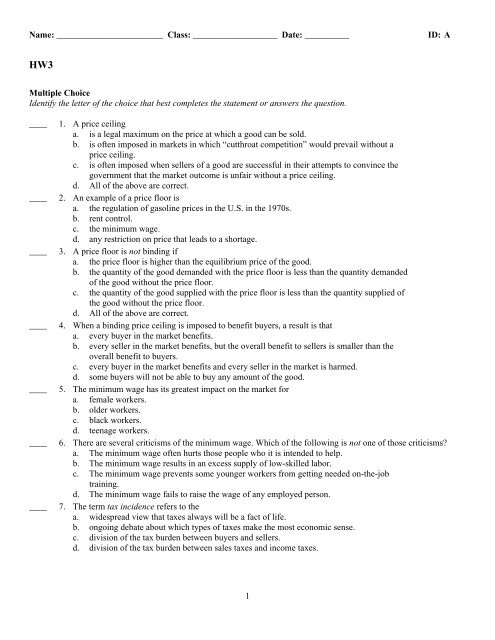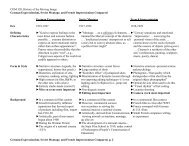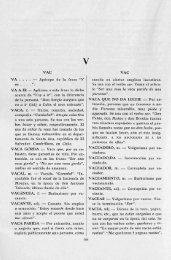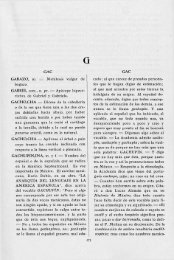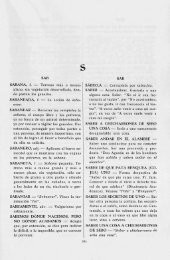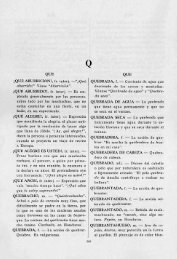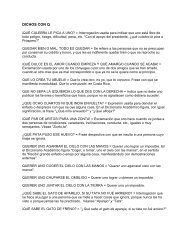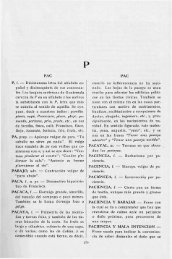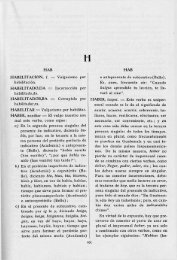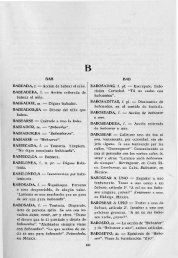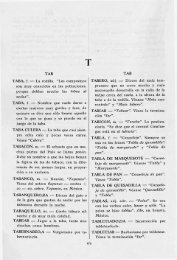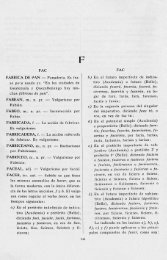Answers to HW3 - Academic Csuohio
Answers to HW3 - Academic Csuohio
Answers to HW3 - Academic Csuohio
You also want an ePaper? Increase the reach of your titles
YUMPU automatically turns print PDFs into web optimized ePapers that Google loves.
Name: ________________________ Class: ___________________ Date: __________ ID: A<br />
<strong>HW3</strong><br />
Multiple Choice<br />
Identify the letter of the choice that best completes the statement or answers the question.<br />
____ 1. A price ceiling<br />
a. is a legal maximum on the price at which a good can be sold.<br />
b. is often imposed in markets in which “cutthroat competition” would prevail without a<br />
price ceiling.<br />
c. is often imposed when sellers of a good are successful in their attempts <strong>to</strong> convince the<br />
government that the market outcome is unfair without a price ceiling.<br />
d. All of the above are correct.<br />
____ 2. An example of a price floor is<br />
a. the regulation of gasoline prices in the U.S. in the 1970s.<br />
b. rent control.<br />
c. the minimum wage.<br />
d. any restriction on price that leads <strong>to</strong> a shortage.<br />
____ 3. A price floor is not binding if<br />
a. the price floor is higher than the equilibrium price of the good.<br />
b. the quantity of the good demanded with the price floor is less than the quantity demanded<br />
of the good without the price floor.<br />
c. the quantity of the good supplied with the price floor is less than the quantity supplied of<br />
the good without the price floor.<br />
d. All of the above are correct.<br />
____ 4. When a binding price ceiling is imposed <strong>to</strong> benefit buyers, a result is that<br />
a. every buyer in the market benefits.<br />
b. every seller in the market benefits, but the overall benefit <strong>to</strong> sellers is smaller than the<br />
overall benefit <strong>to</strong> buyers.<br />
c. every buyer in the market benefits and every seller in the market is harmed.<br />
d. some buyers will not be able <strong>to</strong> buy any amount of the good.<br />
____ 5. The minimum wage has its greatest impact on the market for<br />
a. female workers.<br />
b. older workers.<br />
c. black workers.<br />
d. teenage workers.<br />
____ 6. There are several criticisms of the minimum wage. Which of the following is not one of those criticisms?<br />
a. The minimum wage often hurts those people who it is intended <strong>to</strong> help.<br />
b. The minimum wage results in an excess supply of low-skilled labor.<br />
c. The minimum wage prevents some younger workers from getting needed on-the-job<br />
training.<br />
d. The minimum wage fails <strong>to</strong> raise the wage of any employed person.<br />
____ 7. The term tax incidence refers <strong>to</strong> the<br />
a. widespread view that taxes always will be a fact of life.<br />
b. ongoing debate about which types of taxes make the most economic sense.<br />
c. division of the tax burden between buyers and sellers.<br />
d. division of the tax burden between sales taxes and income taxes.<br />
1
Name: ________________________ ID: A<br />
____ 8. When a tax is imposed on tea and buyers of tea are required <strong>to</strong> send in the tax payments <strong>to</strong> the government,<br />
a. buyers of tea and sellers of tea both are made worse off.<br />
b. buyers of tea are made worse off and the well-being of sellers is unaffected.<br />
c. buyers of tea are made worse off and sellers of tea are made better-off.<br />
d. the well-being of both buyers of tea and sellers of tea is unaffected.<br />
____ 9. If a tax is imposed on a market with inelastic demand and elastic supply,<br />
a. buyers will bear most of the burden of the tax.<br />
b. sellers will bear most of the burden of the tax.<br />
c. the burden of the tax will be shared equally between buyers and sellers.<br />
d. it is impossible <strong>to</strong> determine how the burden of the tax will be shared.<br />
____ 10. Which of the following is the most correct statement about tax burdens?<br />
a. A tax burden falls most heavily on the side of the market that is more elastic.<br />
b. A tax burden falls most heavily on the side of the market that is less elastic.<br />
c. A tax burden falls most heavily on the side of the market that is closer <strong>to</strong> unit elastic.<br />
d. A tax burden is distributed independently of relative elasticities of supply and demand.<br />
____ 11. In 1990, Congress passed a new luxury tax on items such as yachts, private airplanes, furs, jewelry, and<br />
expensive cars. The goal of the tax was <strong>to</strong><br />
a. raise revenue from the wealthy.<br />
b. prevent wealthy people from buying luxuries.<br />
c. force producers of luxury goods <strong>to</strong> reduce employment.<br />
d. limit exports of luxury goods <strong>to</strong> other countries.<br />
____ 12. Which of the Ten Principles of Economics does welfare economics explain more fully?<br />
a. The cost of something is what you give up <strong>to</strong> get it.<br />
b. Markets are usually a good way <strong>to</strong> organize economic activity.<br />
c. Trade can make everyone better off.<br />
d. A country’s standard of living depends on its ability <strong>to</strong> produce goods and services.<br />
____ 13. The area below a demand curve and above the price measures<br />
a. producer surplus.<br />
b. consumer surplus.<br />
c. excess supply.<br />
d. willingness <strong>to</strong> pay.<br />
____ 14. What happens <strong>to</strong> consumer surplus if the price of a good increases?<br />
a. It increases.<br />
b. It decreases.<br />
c. It is unchanged.<br />
d. It may increase, decrease, or remain unchanged.<br />
2
Name: ________________________ ID: A<br />
Figure 7-1<br />
____ 15. Refer <strong>to</strong> Figure 7-1. When the price is P2, consumer surplus is<br />
a. A.<br />
b. B.<br />
c. A + B.<br />
d. A + B + C.<br />
____ 16. Refer <strong>to</strong> Figure 7-1. When the price rises from P1 <strong>to</strong> P2, consumer surplus<br />
a. increases by an amount equal <strong>to</strong> A.<br />
b. decreases by an amount equal <strong>to</strong> B + C.<br />
c. increases by an amount equal <strong>to</strong> B + C.<br />
d. decreases by an amount equal <strong>to</strong> C.<br />
____ 17. Refer <strong>to</strong> Figure 7-1. Area C represents<br />
a. the decrease in consumer surplus that results from a downward-sloping demand curve.<br />
b. consumer surplus <strong>to</strong> new consumers who enter the market when the price falls from P2 <strong>to</strong><br />
P1.<br />
c. the increase in producer surplus when quantity sold increases from Q2 <strong>to</strong> Q1.<br />
d. the decrease in consumer surplus <strong>to</strong> each consumer in the market when the price<br />
increases from P1 <strong>to</strong> P2.<br />
3
Name: ________________________ ID: A<br />
Figure 7-9<br />
____ 18. Refer <strong>to</strong> Figure 7-9. At the equilibrium price, consumer surplus is<br />
a. $480.<br />
b. $640.<br />
c. $1,120.<br />
d. $1,280.<br />
____ 19. Refer <strong>to</strong> Figure 7-9. At the equilibrium price, producer surplus is<br />
a. $480.<br />
b. $640.<br />
c. $1,120.<br />
d. $1,280.<br />
____ 20. Refer <strong>to</strong> Figure 7-9. At the equilibrium price, <strong>to</strong>tal surplus is<br />
a. $480.<br />
b. $640.<br />
c. $1,120.<br />
d. $1,280.<br />
____ 21. Refer <strong>to</strong> Figure 7-9. Assume demand increases and as a result, equilibrium price increases <strong>to</strong> $22 and<br />
equilibrium quantity increases <strong>to</strong> 110. The increase in producer surplus due <strong>to</strong> new producers entering the<br />
market would be equal <strong>to</strong><br />
a. $90.<br />
b. $210.<br />
c. $360.<br />
d. $480.<br />
4
Name: ________________________ ID: A<br />
____ 22. The distinction between efficiency and equity can be described as follows:<br />
a. Efficiency refers <strong>to</strong> maximizing the number of trades among buyers and sellers; equity<br />
refers <strong>to</strong> maximizing the gains from trade among buyers and sellers.<br />
b. Efficiency refers <strong>to</strong> minimizing the price paid by buyers; equity refers <strong>to</strong> maximizing the<br />
gains from trade among buyers and sellers.<br />
c. Efficiency refers <strong>to</strong> maximizing the size of the pie; equity refers <strong>to</strong> producing a pie of a<br />
given size at the least possible cost.<br />
d. Efficiency refers <strong>to</strong> maximizing the size of the pie; equity refers <strong>to</strong> distributing the pie<br />
fairly among members of society.<br />
____ 23. If an allocation of resources is efficient, then<br />
a. consumer surplus is maximized.<br />
b. producer surplus is maximized.<br />
c. all potential gains from trade among buyers are sellers are being realized.<br />
d. the allocation is necessarily equitable as well.<br />
____ 24. At present, the maximum legal price for a human kidney is $0. The price of $0 maximizes<br />
a. consumer surplus, but not producer surplus.<br />
b. producer surplus, but not consumer surplus.<br />
c. both consumer and producer surplus.<br />
d. neither consumer nor producer surplus.<br />
____ 25. Inefficiency can be caused in a market by the presence of<br />
a. market power.<br />
b. externalities.<br />
c. imperfectly competitive markets.<br />
d. All of the above are correct.<br />
____ 26. Suppose the equilibrium quantity in the market for widgets is 200 per month when there is no tax. Then a tax<br />
of $5 per widget is imposed. As a result, the government is able <strong>to</strong> raise $750 per month in tax revenue. We<br />
can conclude that the equilibrium quantity of widgets has fallen by<br />
a. 25 per month.<br />
b. 50 per month.<br />
c. 75 per month.<br />
d. 100 per month.<br />
5
Name: ________________________ ID: A<br />
Figure 8-4<br />
____ 27. Refer <strong>to</strong> Figure 8-4. The price that buyers effectively pay after the tax is imposed is<br />
a. P1.<br />
b. P2.<br />
c. P3.<br />
d. impossible <strong>to</strong> determine from the figure.<br />
____ 28. Refer <strong>to</strong> Figure 8-4. The tax is levied on<br />
a. buyers only.<br />
b. sellers only.<br />
c. both buyers and sellers.<br />
d. This is impossible <strong>to</strong> determine from the figure.<br />
____ 29. Refer <strong>to</strong> Figure 8-4. After the tax is levied, producer surplus is represented by area<br />
a. A.<br />
b. A + B + C.<br />
c. D + E + F.<br />
d. F.<br />
____ 30. Refer <strong>to</strong> Figure 8-4. The benefit <strong>to</strong> the government is<br />
a. measured by tax revenue and is represented by area A + B.<br />
b. measured by tax revenue and is represented by area B + D.<br />
c. measured by the net gain in <strong>to</strong>tal surplus and is represented by area B + D.<br />
d. measured by the net gain in <strong>to</strong>tal surplus and is represented by area D + E.<br />
____ 31. Refer <strong>to</strong> Figure 8-4. The <strong>to</strong>tal surplus (consumer, producer, and government) with the tax is represented by<br />
area<br />
a. C + E.<br />
b. A + B + C.<br />
c. D + E + F.<br />
d. A + B + D + F.<br />
____ 32. The deadweight loss from a tax<br />
a. does not vary in amount when the price elasticity of demand changes.<br />
b. does not vary in amount when the amount of the tax per unit changes.<br />
c. is larger, the larger is the amount of the tax per unit.<br />
d. is smaller, the larger is the amount of the tax per unit.<br />
6
Name: ________________________ ID: A<br />
____ 33. The Laffer curve relates<br />
a. the tax rate <strong>to</strong> tax revenue raised by the tax.<br />
b. the tax rate <strong>to</strong> the deadweight loss of the tax.<br />
c. the price elasticity of supply <strong>to</strong> the deadweight loss of the tax.<br />
d. government welfare payments <strong>to</strong> the birth rate.<br />
____ 34. The view held by Arthur Laffer and Ronald Reagan -- that cuts in tax rates would encourage people <strong>to</strong><br />
increase the quantity of labor they supplied -- became known as<br />
a. California economics.<br />
b. welfare economics.<br />
c. supply-side economics.<br />
d. elasticity economics.<br />
____ 35. Which of the following scenarios is not consistent with the Laffer curve?<br />
a. The tax rate is very low and tax revenue is very low.<br />
b. The tax rate is very high and tax revenue is very low.<br />
c. The tax rate is very high and tax revenue is very high.<br />
d. The tax rate is moderate (between very high and very low) and tax revenue is relatively<br />
high.<br />
____ 36. The higher a country's tax rates, the more likely that country will be<br />
a. at the <strong>to</strong>p of the Laffer curve.<br />
b. on the positively sloped part of the Laffer curve.<br />
c. on the negatively sloped part of the Laffer curve.<br />
d. experiencing small deadweight losses.<br />
____ 37. With which of the Ten Principles of Economics is the study of international trade most closely connected?<br />
a. People face tradeoffs.<br />
b. Trade can make everyone better off.<br />
c. Governments can sometimes improve market outcomes.<br />
d. Prices rise when the government prints <strong>to</strong>o much money.<br />
7
Name: ________________________ ID: A<br />
Figure 9-1<br />
____ 38. Refer <strong>to</strong> Figure 9-1. Without trade, consumer surplus is<br />
a. $210.<br />
b. $245.<br />
c. $455.<br />
d. $490.<br />
____ 39. Refer <strong>to</strong> Figure 9-1. With free trade, this country will<br />
a. import 40 baskets.<br />
b. import 70 baskets.<br />
c. export 35 baskets.<br />
d. export 65 baskets.<br />
____ 40. Refer <strong>to</strong> Figure 9-1. With free trade, consumer surplus is<br />
a. $45.<br />
b. $80.<br />
c. $210.<br />
d. $245.<br />
____ 41. Refer <strong>to</strong> Figure 9-1. With free trade, producer surplus is<br />
a. $80.00.<br />
b. $210.00.<br />
c. $245.50.<br />
d. $472.50.<br />
____ 42. Refer <strong>to</strong> Figure 9-1. As a result of trade, <strong>to</strong>tal surplus increases by<br />
a. $80.<br />
b. $97.50.<br />
c. $162.50.<br />
d. $495.50.<br />
8
Name: ________________________ ID: A<br />
Figure 9-5<br />
____ 43. Refer <strong>to</strong> Figure 9-5. Without trade, the equilibrium price of carnations is<br />
a. $8 and the equilibrium quantity is 300.<br />
b. $6 and the equilibrium quantity is 200.<br />
c. $6 and the equilibrium quantity is 400.<br />
d. $4 and the equilibrium quantity is 500.<br />
____ 44. Refer <strong>to</strong> Figure 9-5. With trade and without a tariff,<br />
a. the domestic price is equal <strong>to</strong> the world price.<br />
b. carnations are sold at $8 in this market.<br />
c. there is a shortage of 400 carnations in this market.<br />
d. this country imports 200 carnations.<br />
____ 45. Refer <strong>to</strong> Figure 9-5. The size of the tariff on carnations is<br />
a. $8 per dozen.<br />
b. $6 per dozen.<br />
c. $4 per dozen.<br />
d. $2 per dozen.<br />
____ 46. Refer <strong>to</strong> Figure 9-5. The imposition of a tariff on carnations<br />
a. increases the number of carnations imported by 100.<br />
b. increases the number of carnations imported by 200.<br />
c. decreases the number of carnations imported by 200.<br />
d. decreases the number of carnations imported by 400.<br />
____ 47. Refer <strong>to</strong> Figure 9-5. The amount of revenue collected by the government from the tariff is<br />
a. $200.<br />
b. $400.<br />
c. $500.<br />
d. $600.<br />
9
Name: ________________________ ID: A<br />
____ 48. Refer <strong>to</strong> Figure 9-5. When a tariff is imposed in the market, domestic producers<br />
a. gain by $100.<br />
b. gain by $200.<br />
c. gain by $300.<br />
d. lose by $100.<br />
____ 49. Refer <strong>to</strong> Figure 9-5. The amount of deadweight loss caused by the tariff equals<br />
a. $100.<br />
b. $200.<br />
c. $400.<br />
d. $500.<br />
____ 50. Refer <strong>to</strong> Figure 9-5. When the tariff is imposed, domestic consumers<br />
a. lose by $500.<br />
b. lose by $900.<br />
c. gain by $500.<br />
d. gain by $900.<br />
10
<strong>HW3</strong><br />
Answer Section<br />
MULTIPLE CHOICE<br />
1<br />
ID: A<br />
1. ANS: A DIF: 2 REF: 6-1 TOP: Price ceilings<br />
MSC: Interpretive<br />
2. ANS: C DIF: 1 REF: 6-1 TOP: Price ceilings, Price floors<br />
MSC: Definitional<br />
3. ANS: C DIF: 3 REF: 6-1<br />
TOP: Price floors, Quantity demanded, Quantity supplied MSC: Analytical<br />
4. ANS: D DIF: 2 REF: 6-1 TOP: Price ceilings<br />
MSC: Interpretive<br />
5. ANS: D DIF: 1 REF: 6-1 TOP: Minimum wage, Labor force<br />
MSC: Interpretive<br />
6. ANS: D DIF: 2 REF: 6-1 TOP: Minimum wage<br />
MSC: Interpretive<br />
7. ANS: C DIF: 1 REF: 6-2 TOP: Tax incidence<br />
MSC: Definitional<br />
8. ANS: A DIF: 2 REF: 6-2 TOP: Tax incidence<br />
MSC: Interpretive<br />
9. ANS: A DIF: 3 REF: 6-2<br />
TOP: Inelastic demand, Elastic supply, Tax incidence MSC: Applicative<br />
10. ANS: B DIF: 2 REF: 6-2 TOP: Elasticity, Tax incidence<br />
MSC: Applicative<br />
11. ANS: A DIF: 1 REF: 6-2 TOP: Luxury tax<br />
MSC: Definitional<br />
12. ANS: B DIF: 2 REF: 7-0 TOP: Economic welfare<br />
MSC: Interpretive<br />
13. ANS: B DIF: 1 REF: 7-1 TOP: Consumer surplus, Demand curve<br />
MSC: Interpretive<br />
14. ANS: B DIF: 2 REF: 7-1 TOP: Consumer surplus<br />
MSC: Interpretive<br />
15. ANS: A DIF: 2 REF: 7-1 TOP: Consumer surplus<br />
MSC: Interpretive<br />
16. ANS: B DIF: 2 REF: 7-1 TOP: Consumer surplus<br />
MSC: Interpretive<br />
17. ANS: B DIF: 3 REF: 7-1 TOP: Consumer surplus<br />
MSC: Applicative<br />
18. ANS: A DIF: 3 REF: 7-3 TOP: Consumer surplus<br />
MSC: Applicative<br />
19. ANS: B DIF: 3 REF: 7-3 TOP: Producer surplus<br />
MSC: Applicative<br />
20. ANS: C DIF: 3 REF: 7-3 TOP: Total surplus<br />
MSC: Applicative<br />
21. ANS: A DIF: 3 REF: 7-3 TOP: Producer surplus<br />
MSC: Applicative
22. ANS: D DIF: 2 REF: 7-3<br />
TOP: Efficiency, Equity, Gains from trade MSC: Interpretive<br />
23. ANS: C DIF: 2 REF: 7-3 TOP: Efficiency<br />
MSC: Interpretive<br />
24. ANS: D DIF: 2 REF: 7-3<br />
TOP: Price ceilings, Consumer surplus, Producer surplus MSC: Applicative<br />
25. ANS: D DIF: 2 REF: 7-4 TOP: Market failures<br />
MSC: Interpretive<br />
26. ANS: B DIF: 3 REF: 8-1 TOP: Tax, Quantity demanded<br />
MSC: Applicative<br />
27. ANS: C DIF: 2 REF: 8-1 TOP: Tax, Equilibrium price<br />
MSC: Applicative<br />
28. ANS: D DIF: 2 REF: 8-1 TOP: Tax<br />
MSC: Interpretive<br />
29. ANS: D DIF: 2 REF: 8-1 TOP: Tax, Producer surplus<br />
MSC: Applicative<br />
30. ANS: B DIF: 2 REF: 8-1 TOP: Tax, Government<br />
MSC: Applicative<br />
31. ANS: D DIF: 2 REF: 8-1 TOP: Total surplus<br />
MSC: Applicative<br />
32. ANS: C DIF: 2 REF: 8-2 TOP: Deadweight losses<br />
MSC: Interpretive<br />
33. ANS: A DIF: 2 REF: 8-3 TOP: Laffer curve<br />
MSC: Definitional<br />
34. ANS: C DIF: 1 REF: 8-3 TOP: Supply-side economics<br />
MSC: Definitional<br />
35. ANS: C DIF: 2 REF: 8-3 TOP: Laffer curve<br />
MSC: Interpretive<br />
36. ANS: C DIF: 2 REF: 8-3 TOP: Laffer curve<br />
MSC: Interpretive<br />
37. ANS: B DIF: 1 REF: 9-0 TOP: International trade<br />
MSC: Interpretive<br />
38. ANS: B DIF: 2 REF: 9-2 TOP: Consumer surplus<br />
MSC: Applicative<br />
39. ANS: D DIF: 2 REF: 9-2 TOP: Exports<br />
MSC: Applicative<br />
40. ANS: B DIF: 2 REF: 9-2 TOP: Trade, Consumer surplus<br />
MSC: Applicative<br />
41. ANS: D DIF: 2 REF: 9-2 TOP: Trade, Producer surplus<br />
MSC: Applicative<br />
42. ANS: B DIF: 3 REF: 9-2 TOP: Trade, Total surplus<br />
MSC: Applicative<br />
43. ANS: A DIF: 1 REF: 9-2<br />
TOP: Equilibrium price, Equilibrium quantity MSC: Interpretive<br />
44. ANS: A DIF: 2 REF: 9-2 TOP: Trade, Prices<br />
MSC: Interpretive<br />
45. ANS: D DIF: 1 REF: 9-2 TOP: Tariffs<br />
MSC: Interpretive<br />
2<br />
ID: A
46. ANS: C DIF: 2 REF: 9-2 TOP: Tariffs, Imports<br />
MSC: Applicative<br />
47. ANS: B DIF: 2 REF: 9-2 TOP: Tariffs, Government<br />
MSC: Applicative<br />
48. ANS: C DIF: 2 REF: 9-2 TOP: Tariffs, Producer surplus<br />
MSC: Applicative<br />
49. ANS: B DIF: 3 REF: 9-2 TOP: Tariffs, Deadweight losses<br />
MSC: Applicative<br />
50. ANS: B DIF: 2 REF: 9-2 TOP: Tariffs, Consumer surplus<br />
MSC: Applicative<br />
3<br />
ID: A
<strong>HW3</strong> [Answer Strip]<br />
_____ A 1.<br />
_____ C 2.<br />
_____ C 3.<br />
_____ D 4.<br />
_____ D 5.<br />
_____ D 6.<br />
_____ C 7.<br />
_____ A 8.<br />
_____ A 9.<br />
_____ B 10.<br />
_____ A 11.<br />
_____ B 12.<br />
_____ B 13.<br />
_____ B 14.<br />
_____ A 15.<br />
_____ B 16.<br />
_____ B 17.<br />
_____ A 18.<br />
_____ B 19.<br />
_____ C 20.<br />
_____ A 21.<br />
_____ D 22.<br />
_____ C 23.<br />
_____ D 24.<br />
_____ D 25.<br />
_____ B<br />
26.<br />
ID: A
<strong>HW3</strong> [Answer Strip]<br />
_____ C 27.<br />
_____ D 28.<br />
_____ D 29.<br />
_____ B 30.<br />
_____ D 31.<br />
_____ C 32.<br />
_____ A 33.<br />
_____ C 34.<br />
_____ C 35.<br />
_____ C 36.<br />
_____ B 37.<br />
_____ B 38.<br />
_____ D 39.<br />
_____ B 40.<br />
_____ D 41.<br />
_____ B 42.<br />
_____ A 43.<br />
_____ A 44.<br />
_____ D 45.<br />
_____ C 46.<br />
_____ B 47.<br />
_____ C 48.<br />
_____ B 49.<br />
_____ B<br />
50.<br />
ID: A
Name: ________________________ Class: ___________________ Date: __________<br />
MULTIPLE CHOICE<br />
1. A B C D E<br />
2. A B C D E<br />
3. A B C D E<br />
4. A B C D E<br />
5. A B C D E<br />
6. A B C D E<br />
7. A B C D E<br />
8. A B C D E<br />
9. A B C D E<br />
10. A B C D E<br />
11. A B C D E<br />
12. A B C D E<br />
13. A B C D E<br />
14. A B C D E<br />
15. A B C D E<br />
16. A B C D E<br />
17. A B C D E<br />
18. A B C D E<br />
19. A B C D E<br />
20. A B C D E<br />
21. A B C D E<br />
22. A B C D E<br />
23. A B C D E<br />
24. A B C D E<br />
25. A B C D E<br />
26. A B C D E<br />
27. A B C D E<br />
28. A B C D E<br />
29. A B C D E<br />
30. A B C D E<br />
31. A B C D E<br />
32. A B C D E<br />
33. A B C D E<br />
34. A B C D E<br />
35. A B C D E<br />
36. A B C D E<br />
37. A B C D E<br />
38. A B C D E<br />
39. A B C D E<br />
40. A B C D E<br />
41. A B C D E<br />
42. A B C D E<br />
43. A B C D E<br />
44. A B C D E<br />
45. A B C D E<br />
46. A B C D E<br />
47. A B C D E<br />
48. A B C D E<br />
49. A B C D E<br />
50. A B C D E<br />
1<br />
ID: A


